Enhancing Teacher Feedback on Student Writing with SkELL
Blanka Pojslová works at Masaryk University Language Centre, Brno, Czech Republic where she teaches Business English and is passionate about feedback and how it can contribute to her students´ language development.
Feedback
Teacher feedback on learners’ written production plays a central role in many writing classes and students perceive their teacher’s feedback as crucial to improving the quality of their writing (Hyland, 2007). Although numerous studies in the 1980s and early 1990s questioned the effectiveness of written teacher feedback, more recent empirical research suggests that feedback does lead to improving the quality of learners’ writing (Hyland, 2006). To maximise the effectiveness of written teacher feedback on learners’ writing, the recommended principles which emerged from feedback research should be followed (Lee, 2008).
These principles indicate that feedback should be timely and balanced (Zamel, 1985; Ferris, 2003), multiple rather than single drafts should be written (Ferris, 1997; Hyland 2006), indirect feedback is more beneficial than direct feedback (Ferris, 2003; Frantzen, 1995), and selective feedback is generally more productive than feedback covering all problematic language in students’ writing production.
Computer-mediated feedback
With the rapid development of educational technologies, computer-mediated feedback (CMF) has become more common in writing classes. CMF can take various forms. In classes where a process-genre approach to writing is adopted, CMF refers to the way human feedback is given by exchanging texts and comments through computer networks. In classes where a product approach to writing is preferred, CMF indicates using sophisticated software which automatically generates immediate evaluative feedback (Ware & Warschauer, 2006) or provides feedback mainly on mechanical and linguistic features (Dikli, 2010).
CMF can be further enhanced using language corpora or corpora-based tools. Teachers can give their students corpora-based indirect feedback by hyperlinking problematic language in learners’ writing to corpus tools or corpus data where learners can check the context or collocations of the words they misused (Milton, 1999). Thus, in classes where multiple-draft feedback on the same text is provided, the corpus as a collection of relevant and authentic texts can offer learners a cognitive support tool to check their evolving hypotheses about language (Hyland, 2006) when preparing another draft of their text. One of the corpora-based tools which can be used to accompany computer-mediated indirect feedback and assist students in improving their writing is web-based tool SkELL (https://SkELL.sketchengine.eu).
What is SkELL
SkELL (Sketch Engine for Language Learning) is a simple web interface derived from Sketch Engine (https://www.sketchengine.co.uk), which is a state-of-the-art web-based tool for building, managing, and exploring large text collections in dozens of languages. SkELL was developed for teachers and learners of English and is based on specially processed corpus data sufficiently covering everyday, standard, formal and professional English. Students and teachers of English can easily check how a particular phrase or word is used by native English speakers and rely on the SkELL corpus because it was especially collected for language teaching and learning purposes (Baisa & Suchomel, 2014).
SkELL provides a search engine that returns concordances, collocations, and related words for a given search term. These three functionalities are called Examples, Word sketch and Similar words. The functionality of Examples (or concordance) will return up to 40 example sentences with a given word or phrase to help the user see how the word or a phrase is used in English. The search is case-insensitive, and the same results will be produced for Rutherford and rutherford. The user does not have to specify the part of speech of the search term as this functionality will yield all parts of speech for the given search term. When searching for water, SkELL will return sentences with water as a noun and as a verb in various forms (watering, watered, waters). Figure 1 illustrates an example of concordance search results for the phrase economic growth.
Figure 1: Example of concordance for the phrase economic growth 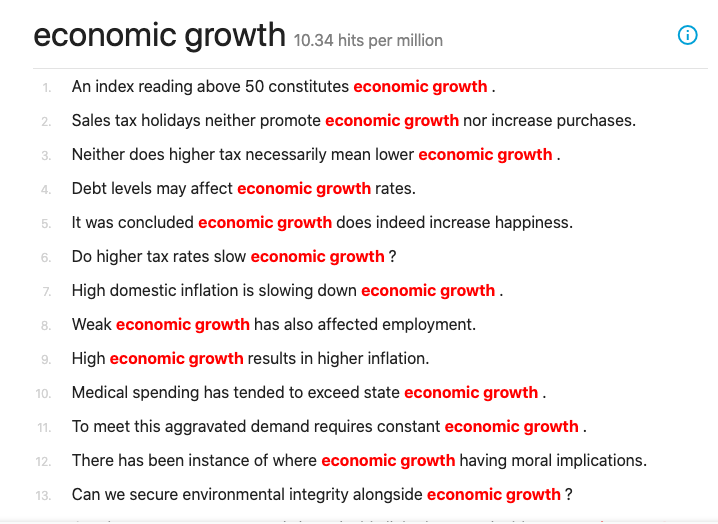
The second functionality is Word sketch (or word profile), which will return the most typical collocations for the search term. The collocations are divided into logical categories for every content word (i.e., noun, adjective, adverb, and verb). This functionality can assist users in finding an appropriate collocate of the search term to sound more natural in a target language.
Within one of the categories, Word sketch will return modifiers of the search content word such as test results, often results in or immensely profitable for content words result (noun and verb) or profitable (adjective). For adjectives (e.g., profitable) and nouns (e.g., results), SkELL will also yield nouns modified by the searched noun or adjective such as a profitable venue or results page. Figure 2 illustrates the example of the Word sketch functionality for the search term economy.
Figure 2: Example of Word sketch for the search term economy
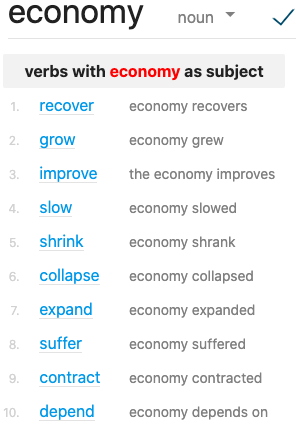
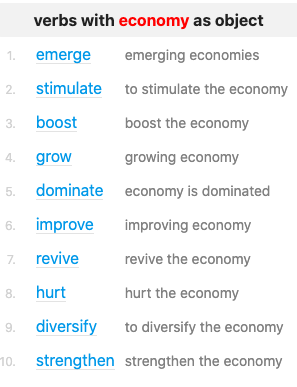
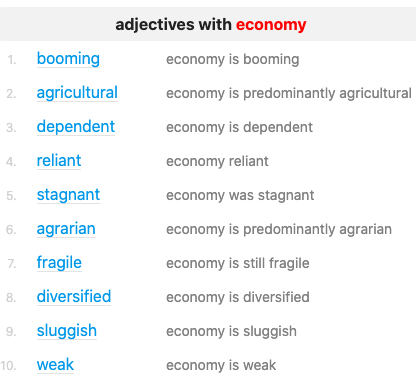
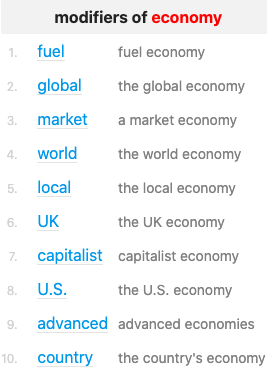
The third functionality is Similar words or thesaurus. This functionality will generate words that are synonymous, related, or similar to the search term. These words will be visualized in a word cloud to indicate the extent to which each word in the word cloud is similar to the search term. The more central the word is in the word cloud, the more similar or related it is to the search term. If the search term can have more than one part of speech, alternative results for other parts of speech can be generated. Figure 3 illustrates an example of the Similar words functionality for the search term profitable.
Figure 3: Example of Similar words for the search term profitable
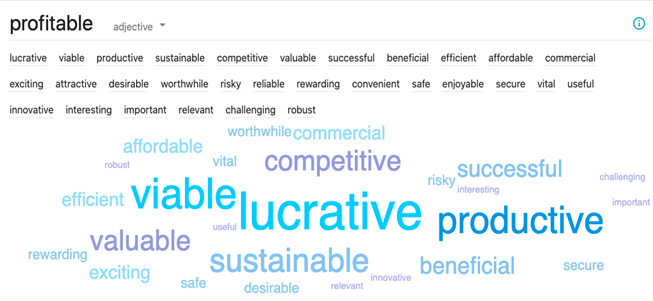
The word cloud generated by the Similar words function might sometimes include words that do not seem similar to the search term. This is because of the technology used for identifying synonyms in the automatically generated thesaurus, and thus this functionality might occasionally yield inappropriate words. To limit these words, it is possible to click the questionable word to open Examples and Word Sketch and check the word in the example sentences or in collocations. Figure 4 below illustrates how SkELL interconnects the functionalities Examples, Word Sketch and Similar.
Figure 4: Comparing SkELL functionalities for the search term profitable 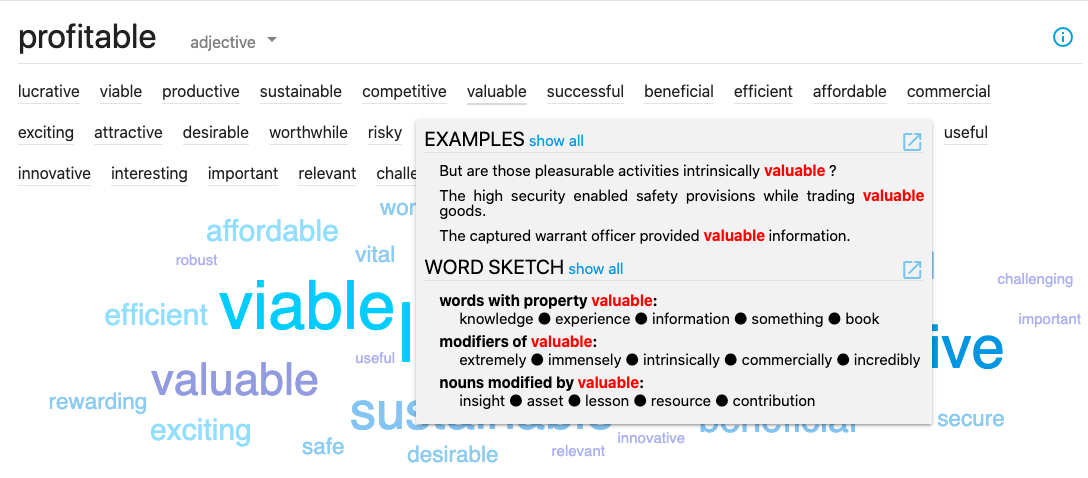
Corpus-based feedback
Background
Students of the Business English course at the Faculty of Economics, Masaryk University, Czech Republic have been provided with CMF on their writing for more than 15 years. Teachers of this course tend to adopt the process-genre approach to teaching writing and strive to give feedback in line with recommended principles of feedback provision, which means that the feedback is timely, specific, multiple-draft, selective, and indirect.
Indirect feedback might be provided in various forms one of which is colour-coded feedback covering five broad categories: organisation; mechanics; academic style; vocabulary; and grammar. Using different colour codes linked to these categories, the teachers highlight problematic language in the students´ writing. The indirect colour-coded feedback might be further supplemented by hyperlinking problematic language to external sources that offer a detailed explanation, metalinguistic or corpus-based information. Indirect feedback is combined with comments on genre-related problems which can be also hyperlinked to online external sources with a particular genre description. Figure 5 illustrates the example of indirect colour-coded feedback on student´s writing.
Figure 5: Example of indirect colour-coded feedback on a student’s writing
SkELL-based feedback
The term collocation refers to the tendency of words to occur in the close environment of particular other words (Anderson & Corbett, 2009). Firth (1935) argues that the meaning of a word is as much a matter of how it combines with other words in actual use (i.e., its collocations) as it is of the meaning it possesses itself. Although students’ general vocabulary knowledge might be good, their knowledge of collocations is usually below their general vocabulary knowledge (Bahns & Eldaw, 1993). Moreover, when trying to express themselves in writing students usually cannot rely on their intuition or specific rules regarding the appropriate use of collocations, so teachers need to offer them more specific and at the same time authentic assistance, which may take the form of corpus-based feedback.
Corpus information can be added to indirect feedback using SkELL to offer students help with finding the correct or appropriate collocation or a more formal expression or with checking how a given word or phrase behaves in English. In doing so, teachers indicate an inappropriate collocation or misused expression in a student’s text and hyperlink it to SkELL together with instructions specifying which search term to focus on. This corpus-based indirect feedback makes learners consult corpora themselves and may assist in improving their use of collocations in a subsequent draft. Table 1 illustrates examples of corpus-based feedback on noun–verb collocations with the revisions writers undertook in the subsequent versions of their texts.
Table 1: Examples of corpus-based feedback on noun–verb collocations
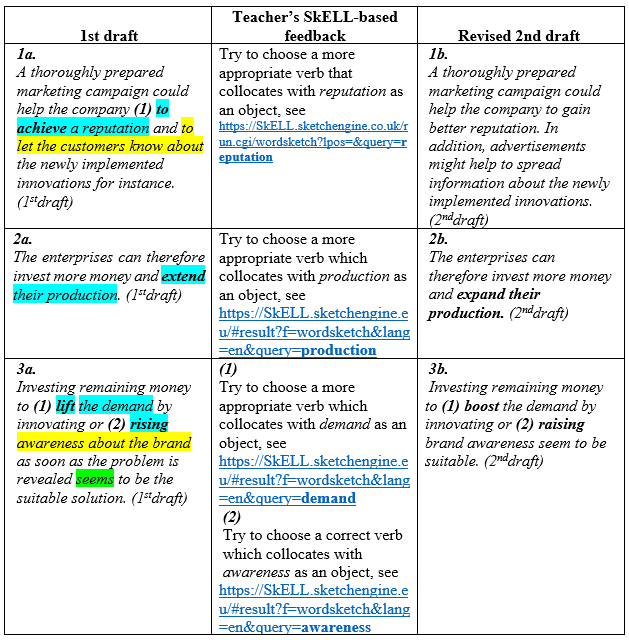
Similar corpus-based feedback might be provided on the appropriate use of modifiers of nouns or adjectives. Table 2 illustrates examples of corpus-based feedback on adjective–noun collocations with the revisions writers undertook in the subsequent versions of their texts.
Table 2: Examples of corpus-based feedback on adjective–noun collocations
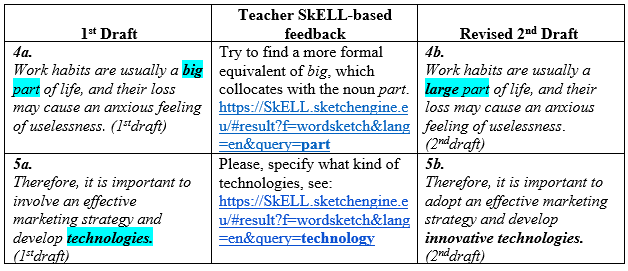
Conclusion
Feedback is a powerful pedagogical tool, and its efficacy largely depends on how it is provided. Feedback on writing production can benefit from the developments in digital technologies and corpus linguistics in many ways, one of which might be the implementation of relevant and authentic corpus-based language information in the process of feedback provision. To achieve this, the user-friendly web-based corpus tool SkELL developed for language teachers and learners can be used. SkELL does not require any extensive input, registration, or payment and is self-explaining and intuitive for its users, whether language teachers or language learners.
References
Anderson, W., & Corbett, J. (2009). Exploring English with online corpora. Palgrave Macmillan: Basingstoke, Hampshire.
Bahns, I., & Eldaw, M. (1993). Should we teach EFL students collocations? System, 21(1), 101–114.
Baisa, V., & Suchomel, V. (2014). SkELL: web interface for English language learning. In: Horák, A., & Rychlý, P. (Eds.), Proceedings of Recent Advances in Slavonic Natural Language Processing, RASLAN, 63–70.
Dikli, S. (2010). The nature of automated essay scoring feedback. Calico Journal, 28, 99–134.
Ferris, D. R. (1997). The influence of teacher commentary on student revision. TESOL Quarterly, 31, 315–339.
Ferris, D. R. (2003). Response to student writing: implications for second language students. Routledge: Taylor & Francis Group.
Firth, J. R. (1935). The technique of semantics. Transactions of the Philological Society, 36–72.
Frantzen, D. (1995). The effects of grammar supplementation on written accuracy in an intermediate Spanish content course. Modern Language Journal, 79, 244–329.
Hyland, K., & Hyland, F. (2006). Feedback on second language students' writing. Language Teaching, 39(2), 83–101.
Hyland, K. (2007). Second language writing. Cambridge: Cambridge University Press.
Lee, I. (2008). Understanding teachers' written feedback practices in Hong Kong secondary classrooms. Journal of Second Language Writing, 17(2), 69–85.
Milton, J. (1999). Lexical thickets and electronic gateways: Making text accessible by novice writers. In C. Candlin & K. Hyland (Eds.), Writing: Texts, processes and practices. London: Longman, 221–243.
SkELL (Sketch Engine for Language Learning): Lexical Computing Ltd. (2014–2018).
http://SkELL.sketchengine.co.uk/run.cgi/SkELL
Ware, P. D., & Warschauer, M. (2006). Electronic feedback and second language writing. In K. Hyland & F. Hyland (Eds.), Feedback in Second Language Writing (pp. 105-122). New York: Cambridge University Press.
Zamel, V. (1985). Responding to student writing. TESOL Quarterly, 21, 697–715.
Please check the Pilgrims f2f courses at Pilgrims website.
Please check the Pilgrims online courses at Pilgrims website.
Scaffolding Presentation Skills with Peer Feedback and Assessment
Blanka Pojslová, the Czech RepublicFeedback Time, The Time of Learning: Guiding a STEM-oriented Presenter in Learning to Self-reflect
Eva Rudolfová, the Czech Republic;Marcela Sekanina Vavrinová, the Czech RepublicEnhancing Teacher Feedback on Student Writing with SkELL
Blanka Pojslová, the Czech Republic